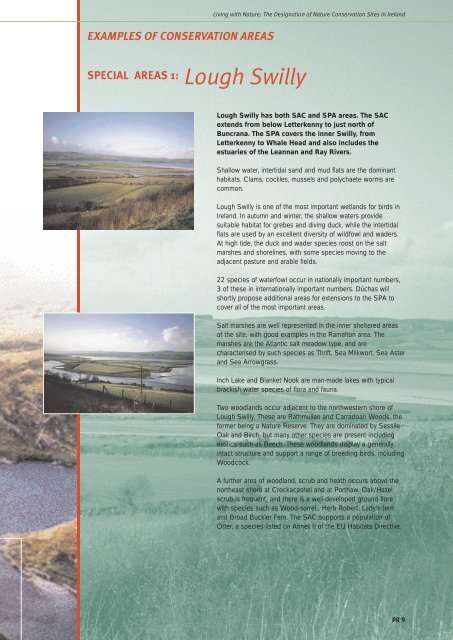The Designation of Nature Conservation Sites in Ireland
The Designation of Nature Conservation Sites in Ireland
The Designation of Nature Conservation Sites in Ireland
You also want an ePaper? Increase the reach of your titles
YUMPU automatically turns print PDFs into web optimized ePapers that Google loves.
EXAMPLES OF CONSERVATION AREAS<br />
SPECIAL AREAS 1: Lough Swilly<br />
Liv<strong>in</strong>g with <strong>Nature</strong>: <strong>The</strong> <strong>Designation</strong> <strong>of</strong> <strong>Nature</strong> <strong>Conservation</strong> <strong>Sites</strong> <strong>in</strong> <strong>Ireland</strong><br />
Lough Swilly has both SAC and SPA areas. <strong>The</strong> SAC<br />
extends from below Letterkenny to just north <strong>of</strong><br />
Buncrana. <strong>The</strong> SPA covers the <strong>in</strong>ner Swilly, from<br />
Letterkenny to Whale Head and also <strong>in</strong>cludes the<br />
estuaries <strong>of</strong> the Leannan and Ray Rivers.<br />
Shallow water, <strong>in</strong>tertidal sand and mud flats are the dom<strong>in</strong>ant<br />
habitats. Clams, cockles, mussels and polychaete worms are<br />
common.<br />
Lough Swilly is one <strong>of</strong> the most important wetlands for birds <strong>in</strong><br />
<strong>Ireland</strong>. In autumn and w<strong>in</strong>ter, the shallow waters provide<br />
suitable habitat for grebes and div<strong>in</strong>g duck, while the <strong>in</strong>tertidal<br />
flats are used by an excellent diversity <strong>of</strong> wildfowl and waders.<br />
At high tide, the duck and wader species roost on the salt<br />
marshes and shorel<strong>in</strong>es, with some species mov<strong>in</strong>g to the<br />
adjacent pasture and arable fields.<br />
22 species <strong>of</strong> waterfowl occur <strong>in</strong> nationally important numbers,<br />
3 <strong>of</strong> these <strong>in</strong> <strong>in</strong>ternationally important numbers. Dúchas will<br />
shortly propose additional areas for extensions to the SPA to<br />
cover all <strong>of</strong> the most important areas.<br />
Salt marshes are well represented <strong>in</strong> the <strong>in</strong>ner sheltered areas<br />
<strong>of</strong> the site, with good examples <strong>in</strong> the Ramelton area. <strong>The</strong><br />
marshes are the Atlantic salt meadow type, and are<br />
characterised by such species as Thrift, Sea Milkwort, Sea Aster<br />
and Sea Arrowgrass.<br />
Inch Lake and Blanket Nook are man-made lakes with typical<br />
brackish water species <strong>of</strong> flora and fauna.<br />
Two woodlands occur adjacent to the northwestern shore <strong>of</strong><br />
Lough Swilly. <strong>The</strong>se are Rathmullen and Carradoan Woods, the<br />
former be<strong>in</strong>g a <strong>Nature</strong> Reserve. <strong>The</strong>y are dom<strong>in</strong>ated by Sessile<br />
Oak and Birch, but many other species are present <strong>in</strong>clud<strong>in</strong>g<br />
exotics such as Beech. <strong>The</strong>se woodlands display a generally<br />
<strong>in</strong>tact structure and support a range <strong>of</strong> breed<strong>in</strong>g birds, <strong>in</strong>clud<strong>in</strong>g<br />
Woodcock.<br />
A further area <strong>of</strong> woodland, scrub and heath occurs above the<br />
northeast shore at Crockacashel and at Porthaw. Oak/Hazel<br />
scrub is frequent, and there is a well-developed ground flora<br />
with species such as Wood-sorrel , Herb Robert, Lady’s fern<br />
and Broad Buckler Fern. <strong>The</strong> SAC supports a population <strong>of</strong><br />
Otter, a species listed on Annex II <strong>of</strong> the EU Habitats Directive.<br />
pg 9
















